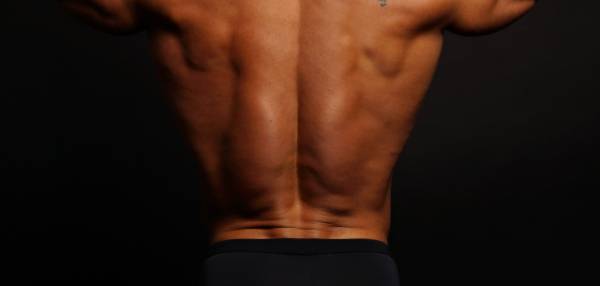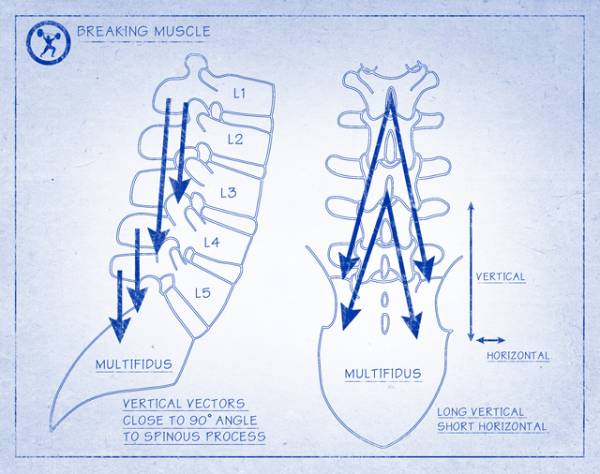So, Grasshopper, why are you sitting there contemplating your navel? Oh, right, because you hurt your back and the authorities told you to “pull your belly button in” and that until you could isolate your holy of holies – the mystical transverse abdominis (TVA) – you could not progress any further.
I have the secret for you. The secret that will set you free. It is the answer to the age-old Buddhist question, “What is the sound of the one-hand clap?” I’m going to tell you the answer. Close your eyes and concentrate upon pulling your navel in towards your spine (using your TVA, of course), and listen closely, because the next sound you hear will be the sound of my large, calloused, open hand smacking loudly into the side of your thick skull, knocking some badly needed sense into it.
You have just learned the secret of the one-hand clap. Now that I have assisted you in forgetting all about your TVA, it is time pay attention to the real world.
“Let’s begin with a question, ‘What are the spinal muscles most important for maintaining the lumbar lordosis when squatting, deadlifting, and in general functional activity?’”
Dismantling the Multifidus Myth
I expect you have read my previous articles dismantling the false prophets of the TVA and Multifidus Cult. If you have not, then you will find their perusal most beneficial after reading this article. In those articles, I had promised a discussion upon the rehabilitation progressions that related to my protocols for lumbar spine injury recovery.
So, let’s begin with a question, “What are the spinal muscles most important for maintaining the lumbar lordosis when squatting, deadlifting, and in general functional activity?” No, this is not a trick question.
Please, don’t tell me you said “multifidus.” And, please, don’t tell me you are a physical therapist, chiropractor, osteopath, or any other college-graduated science professional and answered “multifidus.” If you are currently being treated for a low back condition, then perhaps you should ask this question to your treating practitioner. If they say “multifidus,” hand them a copy of this article.
Meet my friends iliocostalis and longissimus. If you deadlift often enough, then the people who walk behind you at the beach have already met them. You know them as those two big lumps of muscle on either side of your spine, sitting above the lumbar spine in the lower thoracic region.

Okay, now strap yourself in tight. I am going to do a bit of necessary anatomy here. I will attempt to produce the single clearest explanation possible, so you will be able to understand and communicate to others this absolute keystone to fundamental functional strength and rehabilitation science.
The Three Spinal Muscles That Produce Lumbar Lordosis
Let’s consider that there are three muscle groups that have a significant functional ability to influence the production of lumbar lordosis and extension.
In a pre-emptive strike, let me state clearly to the miseducated that the psoas has no significant role in lumbar lordosis. It is a hip flexor. It is mythology that it “produces lordosis.” Happy to discuss that another time, but don’t comment on it here, okay? Wait for the psoas article. And yes, latissimus dorsi also has a role in lumbar stability via the lumbodorsal fascia, but the forces are less significant than the muscles that will be the focus of this article.
Now let’s get to the three spinal muscles that actually, primarily in function, produce lumbar lordosis. Iliocostalis, longissimus, and multifidus. That’s it folks. You now know their names. Now crack your favorite energy drink and get ready for more.
The focus of this article is to educate you as to how and why Iliocostalis and longissimus are the muscles you need to understand to be able to create a program aimed at controlling and holding neutral lordosis under load. To do this I’m going to show you the best way to understand the functional anatomy, not the textbook anatomy.
“Let me state clearly to the miseducated that the psoas has no significant role in lumbar lordosis. It is a hip flexor.”
Getting Your Head Around Iliocostalis and Longissimus
If you open a regular anatomy text you will see that longissimus and iliocostalis are each defined as having two components:1
- Longissimus thoracis pars lumborum
- Longissimus thoracis pars thoracis
- Iliocostalis lumborum pars lumborum
- Iliocostalis lumborum pars thoracis
To get the functional understanding, I arrange them into the area of attachment. So you get them defined as:
- Longissimus thoracis pars thoracis
- Iliocostalis lumborum pars thoracis
- Longissimus thoracis pars lumborum
- Iliocostalis lumborum pars lumborum
The attachment pars thoracis or pars lumborum indicates where that muscle attaches. As such, you now know that longissimus and iliocostalis have both thoracic and lumbar components. As such, those components act differently in function. So rather than differentiate the muscles anatomically from each other, you differentiate them functionally.
Left: Iliocostalis; Right: Longissimus
Physics Makes the World – and Lumbar Lordosis – Go Around
I bet no one ever told you, at that fine educational institution that certified you, that as a personal trainer you’d actually need an understanding of applied mathematics and physics to train people safely. In fact, you do.
You don’t like it? Go back to being a life coach then. It is not negotiable. Fortunately, I’m here to present a clear and simple model of the muscle forces of the lumbar spine.
Vectors for the Lumbar Spine
Bear with me, stop shaking, this won’t hurt too much. Vectors are the lines we use to demonstrate forces. When understanding a muscle’s action, the vector’s length and direction help us to understand its effect upon the joint we are examining.
Vectors have two dimensions – length and direction. Applying this vector line to the joint we can see the force applied to the joint. The direction will tell us how much compression force there is and how much shear force there is when we resolve it into its components. Compression is the force going through the joint. Shear is the force going across the joint.
Now, wipe the sweat from your brow. I’m not going to go any deeper in this article. This is simply a method to help us evaluate the contribution of the muscle to the task. So each muscle that we examine in this article will have a force that compresses the vertebral segment in a vertical direction and a force that pulls it backwards (shear) in a horizontal direction.
“Vectors are the lines we use to demonstrate forces. When understanding a muscle’s action, the vector’s length and direction help us to understand its effect upon the joint we are examining.”
Vectors for Iliocostalis and Longissimus (Pars Thoracis)
Arising all the way from the upper thoracic spine at T1 and each of the thoracic vertebra to T12, the longissimus pars thoracis attaches from each of the thoracic vertebral ribs and transverse processes. They then attach to the lumbar spine and sacrum and form the erector spinae aponeurosis, which covers the pars lumborum musculature. Meaning the effect is behind the lumbar components. The iliocostalis pars thoracis arises from the lowest 7 or 8 ribs and attaches to the ilium and sacrum via tendons as the erector aponeurosis.
Plain English: These muscles come from your thoracic spine and attach on your pelvis and sacrum behind the other lumbar muscles. They have a large compressive and minimal shear force.
Vectors for Iliocostalis and Longissimus (Pars Lumborum)
These muscles lie lateral to the multifidus muscle in the lumbar spine. The longissimus attach to the medial area on the transverse processes of the lumbar vertebrae. The Iliocostalis from the more lateral tips of the transverse processes
Each different vertebral attachment has a slightly different vector due to its individual attachment and insertion on the ilium, and in the case of iliocostalis, also the thoracolumbar fascia. Naturally, the lowest muscle components have the greatest shear/horizontal force vector and the higher have more compressive/vertical vectors.
Vectors for Multifidus
Multifidus is the largest lumbar muscle group. I’ll cut though the anatomical nomenclature and give you a scaled down overview of the multifidus. In a basic description, multifidus is attached at the spinous process of each lumbar vertebra and its surrounds. It has five parts that attach to each of the vertebra and sacrum below.
Due to their small spans between adjacent vertebrae, multifidus forces are segmental in nature. It is a bit dense to draw multifidus in its entirety without losing an understanding of the individual contributions. So the graphic here is representative of the general vector resolution. Naturally, being the closest to the joint, these muscles act with weaker force than the tendons of the pars thoracis components of the erector spinae, which are furthest from the joint.
The Most Important Muscle Group for Neutral Spine Control
So effectively, the pars thoracis group contracting uses its tendons and the erector spinae aponeurosis to produce and maintain the lumbar lordosis under load. Its distance from the vertebral column, placed furthest from the vertebral bodies enhances its effect on the lumbar lordosis like a bowstring on a hunting bow.
This is the most powerful and important muscle group we use in training for lumbar lordosis and neutral spine control. The segmental control at an individual vertebral level is contributed greater by the pars lumborum and multifidus groups. It is failure at these individual levels that causes the individual buckling of a segment that exposes the passive structures (ligaments and disc) to load and consequent injury.
The erroneous focus by rehabilitation professionals upon the multifidus muscle group to control and produce neutral spine posture is the source of many failed low back rehabilitation programs.
So, those of you who asked about the Functional Strength Rehabilitation model I created to work with low back injured athletes can begin to understand a part of my base strategy that is applied after the resolution of the acute disc symptoms. The system is broad and algorithmic in nature and involves the interaction of a lot of components. Those of you who attend any of my lumbar rehab courses will find this article worth committing to memory.
“The erroneous focus by rehabilitation professionals upon the multifidus muscle group to control and produce neutral spine posture is the source of many failed low back rehabilitation programs.”
Okay, that was a quick overview, and I’ve left out some of the more subtle muscle and fascial influences. This article is what it is. An overview and explanation of the most important contributor to lumbar lordosis and neutral spine control kept to a bit over 1,500 words.
References:
1. Macintosh JE, Bogduk N : “The morphology of the lumbar erector spinae.” Spine 1986 12: 658-668
2. Bogduk, N. Clinical Anatomy of the Lumbar Spine and Sacrum 3rd Ed. 1997.
3. McGill, S. Low Back Disorders. 2nd Ed. 2007
Photo 1 courtesy of Shutterstock.
Photo 2 modified by Uwe Gille (Gray Image:Gray389.png) [Public domain], via Wikimedia Commons.










